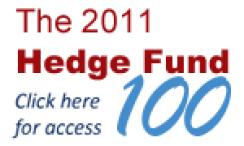
“The industry has gotten a very good physical going through the crisis,” says Howard Altman, Co-CEO of Rothstein Kass and Principal-in-Charge of the firm’s Financial Services Group, which recently published its fifth annual report on hedge fund industry trends, aptly called: 2011 Hedge Fund Outlook: Brighter Days Ahead? “It is clear to grow. There is going to be asset growth, performance growth and more talent to drive that growth than ever before.”
Even so, not every firm is participating is this growth. In fact, in the past year a number of firms have decided to shut down altogether amid the bull market-led recovery. This includes at least three firms ranked among the 100 largest in the past few years that have closed down or announced plans to close down and return all outside capital. Several others that just missed qualifying for the ranking in recent years also said they will shut down. These closures will impact which firms qualify for the Hedge Fund 100 list in future years.
For example, Stanley Druckenmiller’s Duquesne Capital, which in 2009 was the fortieth largest firm, in late 2010 closed its doors and returned about $12 billion in capital to clients. Two other firms that qualified for this year’s top-100 ranking won’t be around when we compute next year’s list because they decided to return investor capital. They include Chris Shumway’s Shumway Capital Partners (ranked 56 with $8 billion), which in February announced it would return all external capital by the end of March, and Carl Icahn’s Icahn Capital (ranked 69 with $6.6 billion), which in March announced plans to return all outside capital by the end of that month.
Meanwhile, several firms that just missed qualifying for the Hedge Fund 100 list this year no longer will be candidates by the time we put together next year’s ranking. For example, earlier this year Level Global said it would close down its nearly $4 billion operation after Federal agents raided its New York City offices late last year as part of its insider trading probe. No charges have been filed against the firm, which reportedly had plans to expand to $7 billion.
Plainfield Asset Management, whose assets under management have plummeted from $3.6 billion last year to $1.1 billion, said in March it will liquidate its distressed debt hedge fund and return all capital by the middle of 2012 following whistle-blower charges that it overvalued assets.
Also earlier this year, Singapore-based Artradis Fund Management, which managed $4.5 billion as recently as two years ago, said it would close down its $800 million fund after losing money for two straight years.
These firms have closed down for a wide range of reasons. Druckenmiller decided to take his billions of dollars and spend more time on himself and his money on charities.
Shumway decided to give back all money to investors after he received $3 billion in redemptions following an earlier announcement that the fund would be headed by his successful sidekick, Tom Wilcox. Icahn gave back outside capital because he did not want to be responsible for outside investors if there were another market decline.
Other funds were either targets of regulatory investigations or suffering from poor performance.
The seemingly rash of closures, however, is not a big surprise to veteran hedge fund executives. “About eight-to-10 percent of our clients go out of business every year,” says Hans Hufschmid, chief executive officer and a member of GlobeOp, a financial services back-office outsourcing firm that derives about 85 percent of its revenues from hedge funds.
For example, in late 2009 Galleon Group, which ranked 85 in 2009, began winding down its firm after co-founder Raj Rajaratnam was arrested was allegedly engaging in insider trading, while Atticus Capital (number 50 in 2009) shut down its main fund after suffering huge losses in 2008.
In fact, the rate of closures is expected to slow down in the future. According to an annual survey conducted by accounting firm Rothstein Kass, more than 60 percent of hedge fund managers expect that there will be fewer hedge fund closures in 2011 than in 2010.
Meanwhile, several other hedge fund firms that have grown large in recent years have chosen to return small percentages of money to investors. For example, last year Baupost Group’s Seth Klarman agreed to return 5 percent of his capital. “By late 2010, froth had returned to the markets,” Klarman explained to clients in a letter.
Over the years, Appaloosa’s David Tepper has periodically returned capital to investors, including 2008, when he gave back 20 percent of capital on two different occasions. As a result, he rarely comes close to ranking near the top of the Hedge Fund 100 list.
So, where is all of this money that has been returned to investors? Did it disappear from the hedge fund industry? It is hard to know for sure. However, industry experts strongly believe it has been redeployed to other funds. “You can only track it as a function of the aggregate number,” says Kenneth Heinz, President of Hedge Fund Research, which keeps track of this data. “When you see titans close down, I do believe the money is looking to return because it was committed to the hedge funds space,” Altman adds.
In fact, new funds are growing at a much rapid rate that existing funds are closing down. According to Lisa Corvese, managing director, Global business Strategy with PerTrac, a provider of analytics, reporting and communications software for investment professionals, 1,184 new funds were launched last year, up 51 percent from 2009. It calculated total AUM for single-manager hedge funds and fund of funds was $2.1 trillion in 2010.
Altogether, there are 9,572 single-manager hedge funds, although nearly half (3,763) have less than $25 million in AUM, according to PerTrac. In addition, 73 percent of funds reporting AUM of less than $100 million, compared to 79 percent in 2009.
On the other hand, 280 single-manager funds held more than $1 billion in assets, slightly more than existed in 2009. Adds Heinz: “Many funds are looking to aggressively add capital.”







